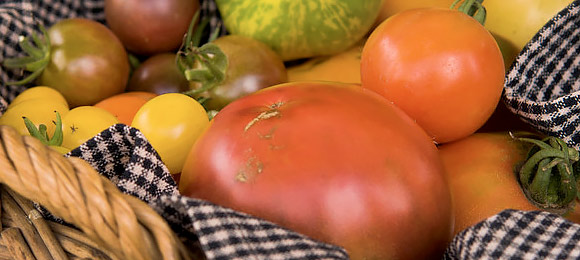Tomato Talk
A Full Season of Tomato-Growing Information
Welcome to Tomato Talk! Each year, we grow some of the Garden's plant giveaways in the Regenstein Fruit & Vegetable Garden’s raised beds, and a few brave staff do the same at home, sharing their gardening trials, tribulations, and successes.

Let's talk about planting.
My tomato plants did not perform well last year. I’m planting recommended varieties, but I was disappointed in the number of tomatoes. What can I do?
It's a common question for our Plant Information Service, and there are many reasons a tomato plant might underperform, but by taking some precautions when planting, you can help ensure a healthy plant and a robust harvest.
1. Tomatoes need sun—not partial sun or dappled shade, but six to eight hours of full, bright sunlight per day. You have got to plant in full sun! Leafy plants that produce large fruit need light. Remember, the amount of flowers (and, therefore, fruit) produced is directly correlated to the amount of sunlight received. If your plants last year looked "leggy" and sparse, or even grew full foliage—but no tomatoes—you will want to reconsider your location. Don't forget that tomatoes grow well in pots, so if you do not have an optimal in-ground or raised bed location, you can plant in pots and place them in a sunny location.
2. You've heard that tomatoes need heat? That means warm soil, too. The midwestern gardener's rule of thumb is to wait until after Memorial Day to plant tomatoes into the ground—they simply won’t thrive until the soil heats up to 55 degrees Fahrenheit or higher at night and daytime temperatures reach 65 to 85 degrees.
3. Tomatoes need soil that’s rich in organic matter. Tomatoes grow best in fertile, well-composted soil (add well-rotted manure and/or shredded leaves) that’s slightly acidic (6.0 to 6.8). Regularly rotate your tomato beds, as disease can strike when tomatoes inhabit the same spot every year. They will often drop their blossoms if temperatures drop below 55 degrees, if there are too many heavy rains or if there are frequent dry winds.
4. Consider how you'll be using your tomatoes when choosing what to plant. See our sidebar for horticultural program specialist Nancy Clifton's picks for saucing, slicing, canning, and juicing tomatoes.
5. A final tip: Plant early-, mid-, and late-season tomato varieties so you can harvest all summer long. Diversity lessens crop failure from insect damage or disease, too.
Tomato Cultivars
Got the basics down, but not sure what different tomatoes are good for canning or slicing? Try these cultivars:
Saucing: Eat 'Ceylon' fresh and you’ll turn up your nose at its sour taste, but it’s one of the best varieties you can grow for tomato sauce.
Slicing: One of summer’s great pleasures is a platter of sliced tomatoes, interleaved with slices of fresh mozzarella and just-picked basil, then drizzled with olive oil. 'Sudduth’s Brandywine'—a separate variety from 'Brandywine'—is tomato pink and beautiful on a plate.
Making tomato paste: 'Costoluto Genovese' is indispensable in the garden—a typical Italian ribbed tomato that makes incredible purées and concentrates.
Canning: 'San Marzano' has an oblong shape that fits neatly in canning jars—that’s one reason it became the first successful commercially canned tomato. Bland eaten fresh, it’s wonderful after cooking.
Stuffing: 'Pink Accordion' is semihollow inside, ruffled on the outside, and lovely stuffed with rice and vegetables.
Juicing: Most eating tomatoes are fine juicers. Non-purists can try mixing the juice of four, five, or six varieties together to create their own signature drink.
Kid-friendly: Cherry and other tiny tomatoes are so sweet and easy to hold that they’re perfect for introducing kids to the world of heirlooms. 'Sara’s Galapagos', a currant tomato that’s even smaller than a cherry, is rated 10 (very high) for sweetness. Skewer and grill cherry tomatoes for a fun side dish.

